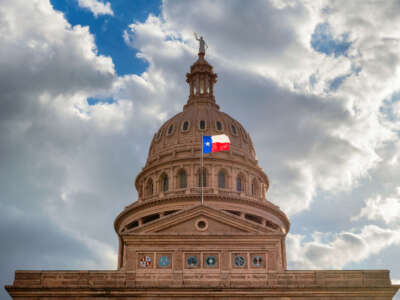Part of the Series
Voting Wrongs
The Supreme Court issued a wave of opinions last week, wrapping a 2024-25 term filled with major victories for Donald Trump’s agenda. Amid high-profile decisions on nationwide injunctions, LGBTQ books, trans health care, and more, the court made the unusual choice to delay a ruling on Louisiana v. Callais: a redistricting case that could alter the future of voting rights across the country.
The court order did not explain the justices’ rationale for seeking a new round of arguments next fall, though it said additional guidance is forthcoming. Experts fear that the court’s 6-3 conservative supermajority is poised to gut the Voting Rights Act of 1965 — widely considered the most important federal law safeguarding the right to vote.
The case took a long and winding road to the Supreme Court, but it has major stakes for democracy. At the center is a legal battle over Louisiana’s congressional maps, which were redrawn by the state’s Republican-controlled legislature after the 2020 census. Louisiana’s population is one-third Black, but lawmakers drew the new map to include only one majority-Black congressional district out of six total. So, in 2022, a coalition of civil rights groups and Black voters filed a federal lawsuit against Louisiana, arguing that the congressional redistricting had diluted the power of Black voters. In that case, Robinson v. Landry, a federal judge for the Middle District of Louisiana agreed that the state had packed Black voters into a single district, likely violating Section 2 of the Voting Rights Act, which prohibits racial discrimination in voting. The finding was upheld on appeal by a bipartisan panel of Fifth Circuit judges.
Never miss another story
Get the news you want, delivered to your inbox every day.
Louisiana lawmakers then had a choice: Draw a new map with two majority-Black districts, or accept congressional lines imposed by the Middle District judge. They chose the former, crafting a new map that both met the state’s Voting Rights Act obligations and protected the seats of two Republican incumbents.
This should’ve ended the dispute. Instead, a group of self-described “non-African American voters” sued the state, claiming that the lawmakers’ consideration of race when drawing the new district lines now violated the 14th Amendment’s Equal Protection Clause. A different district court, the Western District of Louisiana, sided with the plaintiffs and struck down the remedial map in 2024. This is the case, Louisiana v. Callais, that currently lies before the Supreme Court.
If it all seems convoluted, it actually gets worse. In 2023, the Supreme Court decided a near-identical redistricting case, Allen v. Milligan, ruling that Alabama had violated Section 2 of the Voting Rights Act when drawing its congressional districts. Chief Justice John Roberts and Justice Brett Kavanaugh joined the liberal judges to issue a 5-4 opinion, ordering Alabama to add a second majority-Black district. You’d think that the justices could copy-and-paste their prior decision — or that the Western District would have abided by the Allen v. Milligan ruling. Instead, the justices seem to be seriously considering a change of course.
So let’s break this down. Section 2 of the Voting Rights Act bans laws or practices that hinder someone’s right to vote on account of their race. Crucially, it’s a statute that considers impact, not intent. In other words, if lawmakers draw congressional maps in ways that preclude certain racial groups from electing representatives of their choice, it could amount to discrimination, regardless of whether that was the goal. This is what two federal courts found had happened when civil rights groups sued Louisiana in Robinson v. Landry, and why the Fifth Circuit ordered Louisiana to come up with new maps.
The 14th Amendment, meanwhile, enshrines equal protection under the law as a constitutional right. It prohibits racial gerrymandering if race is the predominant factor, outweighing every other consideration in map drawing. As a racial equity legal guide from the University of California-Berkeley explains, state legislatures are “permitted to consider racial demographics in drawing political district boundaries,” and “may even be required to do so in order to protect certain voting rights (such as avoiding vote dilution).”
“Although such activities are clearly ‘race-conscious,’ they are not ‘race-based,’” the guide explains.
This tension is at the core of Louisiana v. Callais, but courts have long held that states have a certain amount of “breathing room” for considering race when drawing maps in order to comply with the Voting Rights Act. Again, the Supreme Court itself upheld this precedent just two years ago. Appellees in Louisiana v. Callais, however, have alleged that the new maps amount to an unconstitutional racial gerrymander.
During oral arguments in March, the conservative justices seemed concerningly ready to backtrack on their own ruling in Allen v. Milligan in Alabama — if not outright hostile to the Voting Rights Act’s core tenets.
Justice Samuel Alito questioned Louisiana’s attorneys on whether the initial Robinson decision on Louisiana’s maps could have been “plainly wrong,” and if that hypothetical were true, would Louisiana’s arguments in defense of the new congressional map still apply. J. Benjamin Aguiñaga, the solicitor general of Louisiana, sounded perplexed. Sure, he said, there could be a hypothetical scenario in which a court might get the Voting Rights Act wildly incorrect by misapplying legal precedent, but that would be a “unicorn case” where “black is green.”
“That case may also never arise,” Aguiñaga said. “But barring that case, when a federal court, two federal courts, ell a state what the law requires, to me, that means that there should be a very, very high bar in this Court’s precedence for second-guessing what those federal courts say.”
Justice Ketanji Brown Jackson, appointed by Joe Biden in 2022, also expressed concerns about Alito’s hypothetical. “We have a prior court order,” she noted. “Having a likely VRA violation is all that was necessary for the state to take steps that it did.”
Justice Neil Gorsuch brought up the argument that Louisiana’s new majority-Black district may not be sufficiently compact to meet legal standards for redistricting. Attorney Stuart Naifeh, arguing the case for the NAACP Legal Defense Fund, responded that the Supreme Court itself had noted in prior rulings that “legislators represent people; they don’t represent geography.”
The crux of Gorsuch’s questioning, however, rested on whether race predominated when drawing the maps — in violation of the 14th Amendment — or whether it was just one consideration. Louisiana maintains that it also redrew the maps to protect political incumbents, making the redistricting permissible.
“Certainly politics played a role in this district, but didn’t race?” Gorsuch asked.
“Absolutely,” Naifeh replied.
“Which is another way of saying race predominated, isn’t it?” Gorsuch continued, seemingly confused about the definition of “predominate.”
Gorsuch, Alito, and Justice Clarence Thomas all voted against the majority in the Alabama decision, so this line of questioning wasn’t shocking. But Kavanaugh and Roberts also seemed skeptical of Louisiana’s new map. Kavanaugh brought up the possibility of a “durational limit” on Section 2 of the Voting Rights Act, after which states would no longer be obliged to engage in race-based redistricting. “On equal protection law, we’ve of course said, and the Court’s long said, that race-based remedial action must have a logical endpoint, must be limited in time, must be a temporary matter,” Kavanaugh said. He cited university admissions as one example, presumably referencing the Supreme Court’s 2023 ruling striking down affirmative action.
Like Gorsuch, Roberts expressed concerns about the new district’s shape.
“It’s a snake that runs from one end of the state to the other,” he said. “I mean, how is that compact?” Naifeh argued that, since it was a remedial, court-ordered map, the state had more breathing room to remedy the Section 2 violation, and that lawmakers had drawn together Black populations with shared historical and community ties.
Advocates were surprised on June 27 when, after months of deliberation, the court ultimately punted the case. It’s unclear what types of new arguments the justices are seeking to elicit. But the March hearing provides a concerning window into some of the court’s thinking. After all, it’s hubristic for the conservative judges to imply that Louisiana should have ignored the lower federal court orders and kept its old map — particularly at a time when defying judges has become commonplace.
The Supreme Court has spent years chipping away at the Voting Rights Act — itself only won after decades of civil rights advocacy — so its 2023 Alabama ruling was a pleasant surprise. Now, however, the justices might undo that one good thing. And now, we’ll have to wait until next term to find out.
Keep the press free. Fight political repression.
Truthout urgently appeals for your support. Under pressure from an array of McCarthyist anti-speech tactics, independent journalists at Truthout face new and mounting political repression.
We rely on your support to publish journalism from the frontlines of political movements. In fact, we’re almost entirely funded by readers like you. Please contribute a tax-deductible gift at this critical moment!
Read full article at source
Stay informed about this story by subscribing to our regular Newsletter


